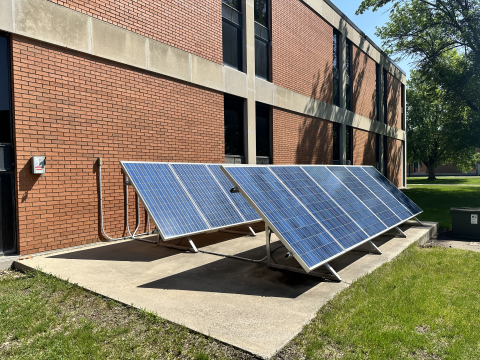
In an era where renewable resources are gaining increasing prominence and support from government authorities, educational institutions are stepping up to incorporate these sustainable technologies into their campuses. North Dakota State College of Science (NDSCS) has taken a proactive approach by installing solar panels and a wind tower, not only to generate clean energy but also to offer valuable learning opportunities to its students. These installations serve as practical tools for students to gain hands-on experience in installation, troubleshooting, and maintenance of renewable energy systems. Let's delve deeper into the significance and impact of these initiatives at NDSCS.
Enhancing Learning Through Renewable Energy
Ivan Maas, Chairman of the Building Systems Department at NDSCS, shares that the integration of solar panels and a wind tower has greatly enhanced the learning experience for NDSCS students. “By providing exposure to renewable energy from an installation and troubleshooting perspective, students become proficient in assisting with the setup of such equipment. This practical experience equips them with valuable skills that align with the growing demand for renewable energy professionals.”
Installation and Gifting of Solar Panels
NDSCS boasts multiple solar arrays on its campus. The first array, a 3.5KW installation, was placed on a dual-axis tracker in 2011-12. It was purchased using a Career and Technical Education (CTE) grant and installed by Enterprise Sales from Valley City, ND. Recently, this array was upgraded to IQ-7+ micro inverters from Enphase, improving its efficiency and allowing direct integration with the NDSCS power grid.
Arrays #2 and #3, each with a capacity of 1.3KW, were also purchased in 2011-12 through the CTE grant. These arrays were installed on a ground-mounted framework built for student accessibility. The DC power generated by these arrays is fed into Barnard Hall, where it is converted into AC power using a Fronius IG inverter before being integrated into the power grid. In 2020-21, NDSCS added another solar array, known as Array #4, with a capacity of 4.4KW. This installation was funded by the NDSCS Electrical Department and installed by Scott's Electric in Wahpeton, ND, under guidance from Lightspring in Bismarck, ND.
The Future Impact of Solar and Wind Technology
Maas believes that wind energy might see limited growth in the residential and light commercial sectors due to initial high costs, maintenance challenges, and grid interconnectivity issues. However, large-scale wind turbine utilization is expected to continue growing steadily. On the other hand, solar energy is predicted to experience high demand and substantial growth. Solar power's predictability and dependability, coupled with the simplicity of maintenance and absence of moving parts, make it an attractive renewable energy option. Maas mentions that solar "farms" will be installed near existing distribution resources, power plants, and wind turbine installations. Some states, like California since 2020, have even enacted laws mandating solar installations on every new home.
Both private individuals and corporations are increasingly opting for solar installations to reduce their reliance on the electrical grid and minimize their carbon footprint.
Understanding Solar Panel Output
Solar panels come in various sizes and power outputs. Small panels with outputs ranging from 15 to 50 watts are suitable for charging small devices in outdoor settings. Residential and commercial panels typically range from 250 to 500 watts each. Multiple panels can be electrically wired together to form a solar array, while large installations with multiple arrays are often referred to as solar "farms." The output of a panel depends on its voltage and current ratings, which must be matched to the specific application for proper and safe operation.
Impact on Higher Education
Maas shares his thoughts on the future collaborations between renewable energy and higher education:
“I don’t know how many campuses have solar generation capability. It will vary greatly by state and region. My guess is that a very small percentage today have renewable sources/assets and it would be very rare to have their entire electrical power needs coming from renewables (solar/wind/etc.).”
“I believe there are not many colleges teaching solar classes. Some may include discussions in renewable energy but very few (like NDSCS) feature full-fledged installation practices. The most widely known training center (nationally) for solar installations is North American Board of Certified Energy Practitioners (NABCEP). NABCEP Certifications are very highly respected and recognized nation-wide. Regionally, several colleges in Minnesota have some instruction in solar installation since Minnesota has aspired to be more proactive on renewable energy production/consumption than other states.”
Article written by NDSCS.